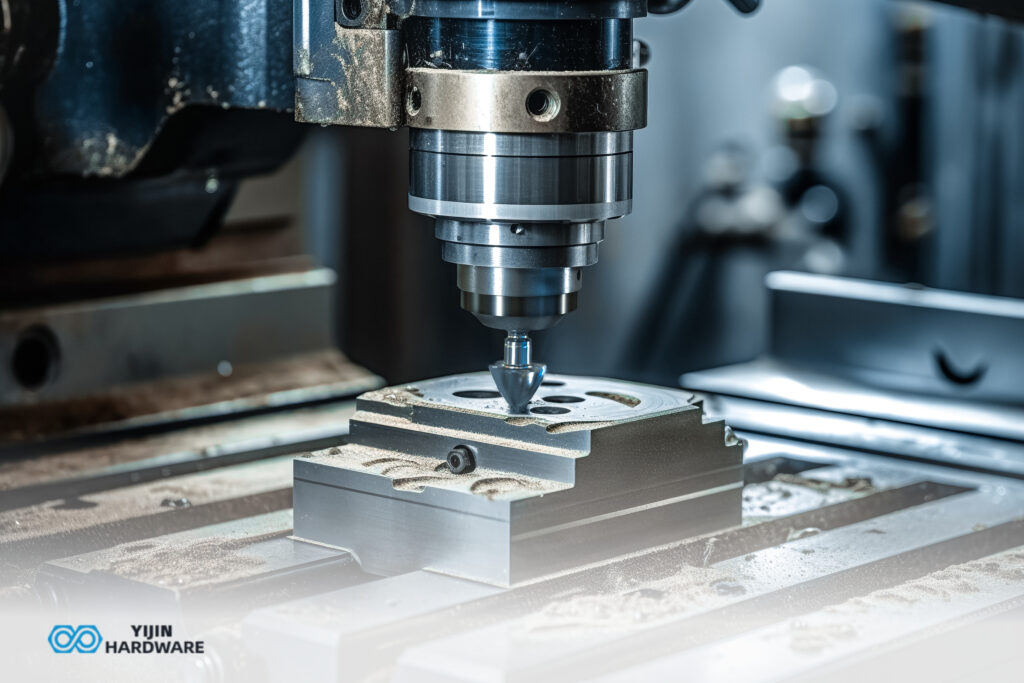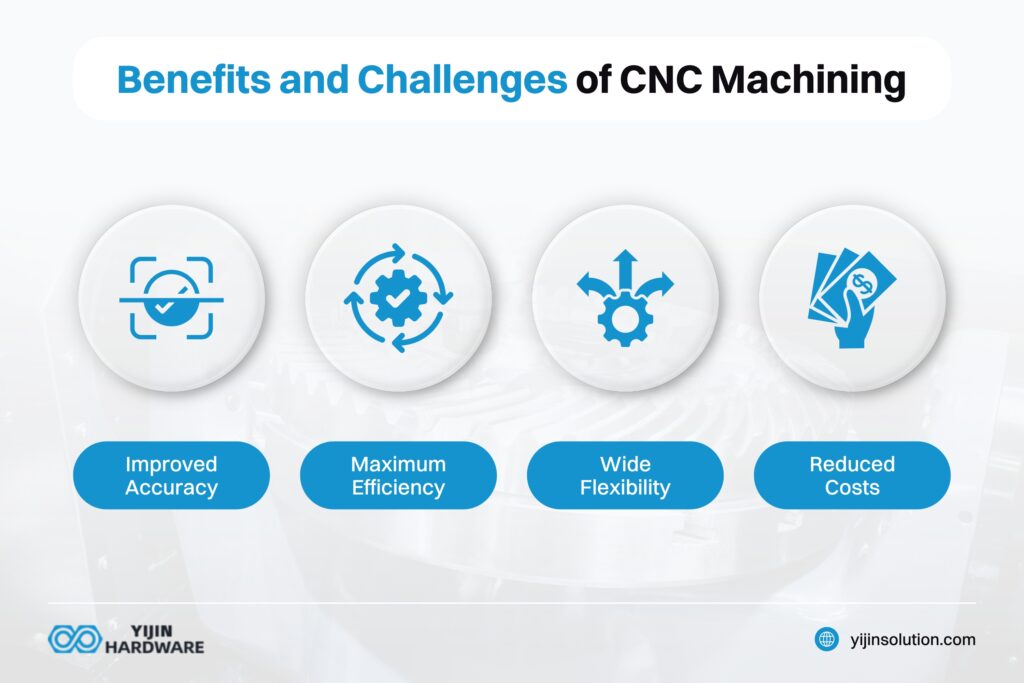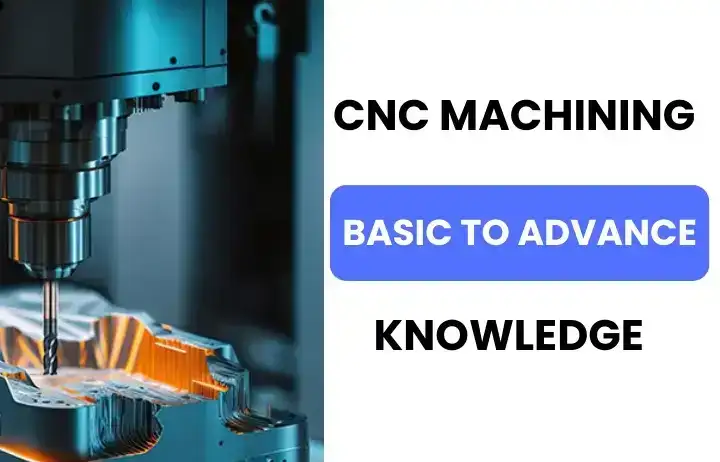Computer Numerical Control (CNC) machining is an automated manufacturing process that uses computer-controlled machine tools to create parts from raw materials. You can use CNC machining for a number of important applications, and it’s unquestionably essential in the modern manufacturing industry.
At Yijin Hardware, we want to make sure you know everything there is to know about CNC machine engineering. Let’s get into what CNC machining is, the different types of CNC machining equipment, CNC benefits, the process, and more.
Key Takeaways
- CNC machining is a manufacturing process that removes material from a workpiece and creates parts.
- The CNC machining process involves creating CAD models, converting files, setting up the machine, and operating it.
- The main types of CNC machines are mills, lathes, plasma cutters, electric discharge machines, and water jet cutters.
- CNC machines improve accuracy, operate continuously, have wide flexibility, and cut long-term costs.
What is CNC Machining?

CNC machining is an automated subtractive manufacturing process, which essentially removes material from a solid block (workpiece). A CNC machine works like this to create specific shapes or machine parts.
The CNC machining process is guided by a computer program (G-code) that converts a digital model into machine instructions. Tool movements are automated to control activities such as cutting, drilling, and shaping. As a result, manufacturers can make complicated parts with exceptional precision in a wide range of industries, including aerospace, automotive, and electronics.
A Brief History of CNC Machining in Manufacturing
The entire concept of Numerical Control (NC) started with John Parsons in the 1940s at MIT. At the time, he was working on improving the efficiency of helicopter blade production. He worked alongside aircraft engineer Frank Stulen, and eventually built a system that used punched tape to control machine tools. The move from NC to CNC programming began in the 1960s, when computers first started to become more widely used. The CNC system made it easier to get accurate control of machining processes.
There are different types of CNC machines, each with its own complex parts used in manufacturing. Notably, using CNC machines results in reduced lead times and improved product quality.
The CNC Machining Process
The CNC process can be a little complicated, but we’re here to break it down. Here are the steps involved in the process in which pre-programmed computer numerical control works to create CNC machined parts:
- CAD Model Creation: A 2D or 3D model of the part is created using Computer-Aided Design (CAD) software. The most commonly used CAD software includes AutoCAD and SolidWorks.
- File Conversion: The CAD model is converted into a CNC-compatible format with computer-aided machining. This is done using Computer-Aided Manufacturing (CAM) software, which then creates G-code.
- Machine Setup: The workpiece is placed on the CNC machine. Then, the appropriate CNC machine tools for cutting are chosen and attached.
- Machine Operation: The CNC machine carries out the programmed instructions. It removes material and creates the part.
Types of CNC Machines
The main types of CNC machines include CNC mills, CNC lathes, CNC plasma cutters, electric discharge machines, and water jet cutters. We’ve detailed them below:
CNC Mills
A CNC milling machine uses rotating cutting tools to remove material from a stationary workplace. For these machines, CNC operations include drilling, boring, and contouring. They are equipped with multiple axes, usually as 3- to 5-axis CNC machining mills. These machines can create complicated geometries and features, such as slots, pockets, and more intricate designs.
CNC Lathes
CNC lathe machines rotate the workpiece while a stationary cutting tool removes material. It’s mainly used for creating cylindrical parts. Some of the most common operations for CNC lathes are turning, facing, and threading. This makes them a great choice for components like shafts, bushings, and fittings.
CNC Plasma Cutters
Plasma cutters are often used in CNC manufacturing for conductive materials. They use a high-velocity jet of ionized gas (plasma) to cut through materials like steel and aluminum. They are incredibly fast and efficient and are widely used in the metal fabrication and construction industries.
Electric Discharge Machines (EDM)
EDMs use electrical discharges (sparks) to erode material from your workpiece. This is really effective for hard metal and parts with intricate shapes. They are frequently used for tooling, die-making, and creating complicated geometries that are difficult to make with traditional machining.
Water Jet Cutters
These are common CNC machines used to cut through a wide variety of materials, including stone, metal, and plastic parts. These cutters use high-pressure water jets mixed with abrasives to achieve this. Water jet cutters are especially effective for delicate materials because they don’t produce heat-affected zones. This makes them a great option for applications that need accurate cutting without thermal distortion.
What are the Benefits of CNC Machining?

CNC machining benefits include excellent precision, continuous operation for faster production, versatility with various materials, and lower costs by minimizing the need for manual labor.
Let’s explore the importance of CNC machining and the many advantages of CNC machining technology:
- Improved Accuracy: CNC machining makes it possible to create parts with very tight tolerances, even within ±0.001 inches (0.03 mm).
- Maximum Efficiency: High-end CNC machines can operate continuously. This can significantly bring down your production time in comparison to manual machining.
- Wide Flexibility: CNC machining can create products while working with a wide range of materials, from metals and plastics to wood and composites.
- Reduced Costs: Since CNC is automated, it reduces the need for skilled, manual labor. This means lower operating costs in the machining industry.
Challenges and Limitations of CNC Machining
In your understanding of CNC, it’s important to know the challenges and limitations of CNC machining systems:
- High Initial Costs: CNC machining and CNC machines can be expensive to buy and set up at first, even though they cut costs in the long term. However, this might be an issue for small businesses.
- Complex Programming: The techniques used in CNC machining require highly skilled personnel. You’re going to have to hire someone with a career as a CNC machinist. A skilled CNC operator can create and troubleshoot CNC programs, especially for complicated designs.
- Material Waste: There are two main types of manufacturing processes: additive and subtractive. As modern CNC machining is a subtractive process, it can cause a lot of material waste in comparison to additive manufacturing processes. Advances in technology have seen the development of hybrid CNC machines, with both additive and subtractive processes that result in reduced waste overall.
What are the Applications of CNC Machining?
CNC machining has applications across a wide variety of industries. Here are the most common applications:
- Aerospace Industry: CNC machines are used for creating accurate components like turbine blades and fuselage parts.
- Automotive Industry: Engine components, chassis parts, and custom tooling are all produced by CNC machines.
- Medical Devices: CNC machining operations can create surgical instruments and implants.
- Consumer Products: CNC machining is also often used in the manufacturing of electronic enclosures, CNC routers, appliances, and furniture.
Choosing the Right CNC Machining Material
Choosing the right CNC machining material can be difficult. Beginners in CNC machining usually mix up or combine the machining requirements for different materials, which can be a problem.
For example, there is a major difference in machining metals and plastic; even different meta-alloys need different feed and speed rates. For a simplified picture, here is an example of a conceptual feed and speed rates table for informational purposes:
| Material | Tool Type | Feed Rate (mm/rev or IPM) | Speed (SFM) |
|---|---|---|---|
| Aluminum (6061) | End Mill (2 Flute) | 0.10 – 0.25 mm/rev (0.004 – 0.010 IPM) | 100 – 300 SFM |
| Drill Bit | 0.05 – 0.15 mm/rev (0.002 – 0.006 IPM) | 50 – 150 SFM | |
| Brass | End Mill (3 Flute) | 0.15 – 0.30 mm/rev (0.006 – 0.012 IPM) | 75 – 200 SFM |
| Tap | 0.08 – 0.12 mm/rev (0.003 – 0.005 IPM) | 25 – 50 SFM | |
| Mild Steel | Ball Nose End Mill | 0.08 – 0.20 mm/rev (0.003 – 0.008 IPM) | 50 – 150 SFM |
| Drill Bit (High-Speed Steel) | 0.03 – 0.10 mm/rev (0.001 – 0.004 IPM) | 30 – 100 SFM | |
| Acrylic | Ball Nose End Mill | 0.20 – 0.40 mm/rev (0.008 – 0.016 IPM) | 100 – 250 SFM |
| Router Bit | 0.30 – 0.50 mm/rev (0.012 – 0.020 IPM) | 75 – 150 SFM | |
| ABS Plastic | End Mill (2 Flute) | 0.15 – 0.30 mm/rev (0.006 – 0.012 IPM) | 75 – 200 SFM |
| Drill Bit | 0.10 – 0.20 mm/rev (0.004 – 0.008 IPM) | 50 – 125 SFM |
Yijin Hardware: Expert CNC Parts Manufacturers
Now that you’re familiar with CNC, you’ll understand that advanced machining processes use contemporary CNC machines to create custom parts. However, if you would like to machine a part, it is always best to contact a professional, qualified company.
Yijin Hardware is a highly experienced CNC parts manufacturer. We provide dedicated, cost-effective, and high-precision CNC machining services. With the latest multi-axis machining, Yijin Hardware can seamlessly manufacture OEM and ODM parts with tight tolerances. Get in touch for a quote!
FAQs on What is CNC Machining?
Is CNC machining hard to learn?
It can be hard to learn everything you need to know about CNC machining. However, if you’re willing to put in at least 3 years of study and hard work, you can become a professional in the CNC industry. It will only take you a few hours of tutorials to make a basic part, though.
What is a CNC machining center?
CNC machining centers are any CNC milling and drilling machines that have an automatic tool changer, table, and clamp for the workpiece. Depending on the position of the spindle, CNC machining centers can be broken down into universal, vertical, horizontal, and gantry types.
What does a CNC machinist do?
A CNC machinist operates and programs machine tools controlled by a computer to create basic parts. For more complicated parts, machinists set up the machines, write and test the programs, and make adjustments if necessary.
Back to Top: What is CNC Machining?

 (+86) 188-2253-7569
(+86) 188-2253-7569
